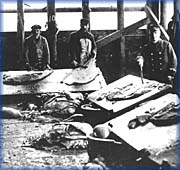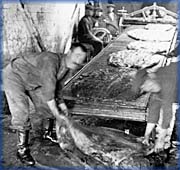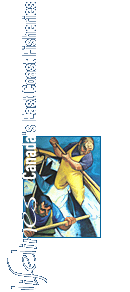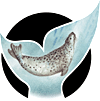|
New technologies changed the transformation of
seal fat into oil from a simple process to one involving expensive
equipment.
 eal blubber was
traditionally scraped from the skin by large numbers of skinners
who deftly wielded knives to avoid damage to the hides. In 1926,
large processors adopted the use of mechanical seal-skinning
machines to save on the cost of labour. eal blubber was
traditionally scraped from the skin by large numbers of skinners
who deftly wielded knives to avoid damage to the hides. In 1926,
large processors adopted the use of mechanical seal-skinning
machines to save on the cost of labour.
|

|

Seal skinners, St. John's, Newfoundland
(Courtesy: Provincial Archives of Newfoundland and Labrador A23-14)
|
|
Originally, the blubber was rendered into oil by placing it in
large vats where it was warmed by the sun and melted. After the
mid-nineteenth century, steam was used to heat the fat, but the
oil was still bleached by exposure to the sun in glass-covered
storage tanks.
|

|

Seal-skinning machines in operation, Bowring
Brothers' factory, ca. 1930
(Courtesy: Provincial Archives of Newfoundland and Labrador,
# 1413 - Garland Collection of T. B. Hayward)
|
|
As with ships, new technologies required substantial capital, so
by 1900 only a few large businesses based in St. John's could
afford to maintain Newfoundland's presence in the seal hunt.
|
|



